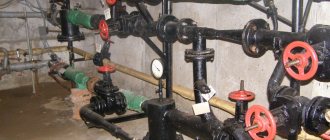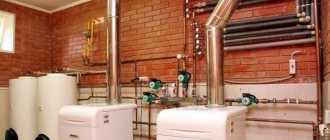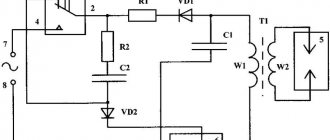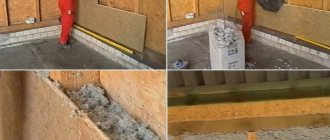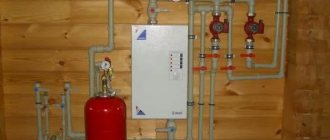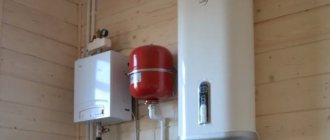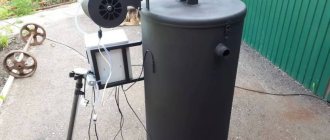Creating heating in your own home implies the use of automation as a mandatory element. You won’t constantly sit in the boiler room and manually monitor the operation of the boiler and other operating parameters of the system itself. And it is better to ensure comfortable conditions in the house not by opening the windows, although no one has canceled ventilation in the rooms, but by setting the desired temperature. These are the tasks that the automation of heating systems performs.
Components of a heating control system
What needs to be automated?
Considering how a house is heated, it should be noted that the operation of the automatic heating system should cover at least the following components:
- heating boiler operation;
- providing comfortable living conditions;
- saving fuel and operating equipment in a gentle manner.
As a rule, when choosing a heating boiler, we already partially determine what kind of heating automation will be used. The fact is that manufacturers of high-quality similar equipment include a heating control unit in the design.
Its task is to create a safe operating mode for the boiler, for which additional sensors are used. As a rule, such a heating system controller monitors safety and provides:
- protection against coolant overheating;
- protection against increases and decreases in pressure in the system;
- control of boiler filling with water;
- control of gas pressure in the line (for gas heating);
- exhaust gas pressure control.
Some of these functions can be installed at the customer’s request (optional), but automatic heating control, at least the operation of the boiler, will be complete with this approach.
The operation of a modern boiler is controlled using a special panel
Advantages and disadvantages
Owners of smart home heating note the following advantages:
- The temperature in the room will correspond to the set parameters, even if the owner has no time to monitor it.
- You can easily check the amount of energy consumed.
- Gas and electricity costs are significantly reduced. Data shows that the average smart home user saves about 30 percent during the heating season.
- The system instantly notifies the owner when device malfunctions are detected.
- It is possible to combine the operation of several heating devices and control them simultaneously.
Among the main disadvantages of such heating is its high cost. You can save a lot of money by doing everything yourself. But to do this you need to have the skills of one of the most qualified specialists in this field. After all, not every technician can handle installing already purchased devices and drawing up a diagram, and only a specialized specialist can carry out further configuration and performance testing. Accordingly, the same problems will arise if it is necessary to repair the system or replace its elements. To avoid this, it is necessary at the first stage to carefully consider the entire organization of work.
About automatic control of the heating system
When considering the automation of heating systems, it should be borne in mind that heating can be controlled by temperature:
GSM module for heating boilers: purpose and operation of the remote controller
- coolant;
- air in the house;
- outside air, weather dependent.
Control systems based on coolant temperature control operate regardless of current conditions. The consequence of this will be high inertia of the entire process, low efficiency and wastefulness. The best results are shown by an automatic heating system that works to maintain the set temperature in the house.
Elements of a weather-compensated heating control system
Weather-dependent regulation is considered the most progressive and effective, since it allows you to quickly respond to changing environmental conditions. However, conventional means that monitor and control the heating system can ensure its fairly efficient operation.
Principle of operation
Some devices simply help maintain the required temperature and save money on it. More complex gadgets are given special algorithms of action. For example, they can automatically change the temperature regime, focusing on the owner’s preferences, day of the week and time of day (at night the temperature should be lower for good sleep, in the morning it should be higher to make it easier to get up for work/school).
Also, the boiler can turn on/off depending on the temperature outside, in the house or in a specific room. It is possible to turn it off remotely to save money and turn it on in advance, before coming into the house. This is especially convenient for large houses with an area of 150-200 square meters.
It is enough to configure the system via a computer or a special application on a smartphone.
How it works
It should be noted here that automation for heating a private home can be built using a variety of devices, operating both autonomously and under the control of centralized systems.
Control using a heating boiler
With this approach, all heating control comes down to setting the temperature of the coolant on the boiler. In this case, the automation built into it begins to work; for heating that works in this way, control on the boiler is quite sufficient. It will maintain the required coolant temperature regardless of its value in the premises.
More details in the article - automation for a heating boiler.
Thermostatic valve
Perhaps this is the simplest automatic heating temperature controller. It is placed on each radiator, and on it (on its head) you can set the desired value. In cases where it becomes too hot, the regulator operates and cuts off the flow of coolant into the battery. When the temperature drops below the set value, the valve opens and water begins to flow into the radiator, heating the room.
Automation for gas heating boilers
Thermostatic valve
Such automation of heating of a private house works without reference to the temperature of the coolant, in fact being universal and independent of the type of boiler used (gas, solid fuel, liquid, etc.).
The disadvantage of this approach is the lack of savings due to the inability to control the boiler and fuel consumption.
Room temperature controller
In this case, a special temperature controller is installed in the room - essentially a heating controller. It changes the heating of the coolant (turning on or off the burners, adjusting the water supply, etc.), providing the desired mode.
Room temperature controller
In fact, in this case, the control is completely electronic; the heating of the house operates according to commands from a special center and can implement any given operating mode. If such a control and regulation structure is equipped with remote communication units and a GSM module, an automated heating system control unit with remote access will be formed.
Automation for pump
Regulates the operation of the system, controlling many functions, such as, for example, pressure, water distribution.
For normal operation, the following components are required: a manifold that provides water supply, a relay that controls the pump, a pressure gauge that measures pressure, a dry-running sensor that prevents the device from overheating if the water runs out.
All automation responsible for the pump is divided into several models, based on the time of creation:
First generation automation;
The first simplest water supply design. Used to solve simple problems when it is necessary to provide a room with a source of water. It consists of three components: a dry running sensor, a hydraulic accumulator that performs the task of accumulating water and contains a membrane, and a relay that controls water pressure. It usually does not cause any difficulties during installation, since the system completely eliminates complex electrical circuits. The mechanism is also extremely easy: the order is cyclical—when the water is completely filled, the pump turns off, then the cycle repeats.
Second generation automation
The sample differs from the previous one in that sensors have been added to the control to monitor the operation. As a result, a hydraulic accumulator is not necessary, since its function is performed by sensors. The second generation automation is not in great demand, as it is similar to the first, but is much more expensive.
Third generation automation
It is a more worthy version of its predecessors, and costs more accordingly. The unit stands out for its greatest reliability, efficiency, improved safety program, and most importantly, maximum accuracy of the device.
To maintain the device in automatic mode, a relay is installed. The mechanism is simple: when the water pressure decreases, the relay starts the system, and similarly, when the pressure increases, it stops.
Thermostat to turn the pump on or off
The most common type of automation for a pump in home heating. Mechanism: first, information is collected from the sensor, then the indicators are compared, the operation of the pump depends on this. For example, if the owner sets the mode to +60 and the hysteresis to +5, then the water must be +65 for the system to start, and for it to stop, the temperature must be +55.
Combined control option
It is worth noting that the joint operation of the regulator and thermostatic valve creates optimal conditions for the system to operate. The heating control controller will ensure economical fuel consumption and air temperature control, and the valve will allow you to maintain the desired mode in each room.
To create optimal parameters for the operation of a heating system, it needs automation tools that not only maintain comfortable conditions, but also provide significant savings in the cost of heating the house.
Why you need to monitor the temperature in your home
In a smart home, the main task of heating is heating and temperature control. After all, you need to understand what will happen if it goes beyond the permissible limits (the optimal room temperature in the warm season is from 22 to 25 degrees, the temperature in the cold season is from 20 to 22 degrees).
Periodic hypothermia is dangerous for everyone. It leads to the development of acute respiratory diseases, disruption of the nervous system, and the appearance of “cold allergies” (in most cases with local skin rashes). In children's rooms, you need to especially carefully monitor the temperature, since the child is sensitive even to changes of a few degrees.
Overheating can also have unpleasant consequences. Firstly, high temperatures are favorable for the growth of bacteria and fungi (for example, mold). Secondly, it contributes to the appearance of general fatigue and increased fatigue. Thirdly, in case of prolonged exposure to elevated temperatures, water-salt metabolism may be disrupted. Fourthly, non-compliance with standards leads to overheating of equipment, the appearance of condensation and static charge at workstations.
Automation of the heating system, what are the problems, is it necessary, when to use it
Also find out in detail whether a hydraulic arrow is necessary in the heating system
But, nevertheless, the specified equipment is installed. In what cases is weather response equipment installed in the heating system?
- Often, residents simply love everything automatic. They like to figure it out and make adjustments. In general, the control equipment for the heating system in this case is considered, like a large car, an expensive pleasure that can be done in your free time (adjusting the heating supply in the house is a new hobby).
- The second option is very complex heating systems with many circuits. If one boiler (group of boilers) powers a couple of objects - a house, a small house, a garage, a steam room, a greenhouse... then it is impossible to manage everything manually and it is necessary to install a fully automatic complex. But at such facilities, in general, there is a full-time technician for maintenance, and the owner does not delve into the intricacies of the heating supply.
- Another option is large heat supply areas, production workshops, with shifting operating modes, etc... With such volumes, even the slightest saving on heating is good money. Thanks to this automation, everything changes.
However, in the vast majority of cases, a simple house up to 400 sq. m. does not require any weather-compensating automation. If residents can adjust the boiler on their own when it gets cold (warming) outside, then this equipment loses all meaning. The electronic controller in the heating system controls not only weather changes, but also other functions. In particular, the management of the hot water supply system is very important. When the electric storage water heater heats up, the heat supply is turned off - the rule of DHW priority in any system. This is performed by an external controller with a floor-standing boiler, or this function is built into automatic boilers. If the equipment is abandoned, then the priority of the electric storage water heater must be ensured by some other means. And this can be created by installing a group of relays and other not simple equipment in the circuit, which is an order of magnitude more affordable than “fencing off” the automation.
Read in detail - how to connect an electric water heater to a non-automatic boiler
If the issue of operating an electric storage water heater with a solid fuel boiler is resolved, then you can completely abandon the automation. It remains to draw conclusions. Weather-compensating automation can be built into a wall-mounted boiler. Then you can easily put it into operation by purchasing an additional external thermal converter - it is very functional and simple. However, if you have a non-automated boiler, then you do not need to install a bunch of complex equipment in addition to it - it is very expensive and ineffective. It is much cheaper and easier to adjust to the weather manually. As an exception, there may be very large houses and large heated farms, where it is impossible to manage without automation.
It’s also interesting to find out how it’s easier and cheaper to install heating in a country house
Where to buy equipment
You can purchase smart heating equipment either in a specialized store or online in an online store. In the second case, the budget option for purchasing products on the Aliexpress website deserves special attention. For some lamps there is an option for shipment from a warehouse in the Russian Federation; they can be received as quickly as possible; to do this, when ordering, select “Delivery from the Russian Federation”
| Heating controller ZONT SMART 2.0 | Smart thermostat AVATTO Tuya with Wi-Fi | Smart radiator drive TRV ZigBee3.0 |
| Smart water heating controller | MoesHouse ZigBee Thermostat | Controller for gas boiler TUYA |
Other devices for temperature control
Table 2. Types of temperature controllers
Thermostat imageVarietyDescription
| Built-in thermostats with water temperature sensor | Capillary thermostats are used to control the operation of hot water boilers |
| Mechanical thermostats | Mechanical temperature controllers are used to maintain the temperature regime, which is set manually using a roller |
| Wired regulators | Thermostats are a simple design that is connected to the electrical network along with the boiler equipment |
| Wireless thermostats | The equipment does not require connection to the electrical network and operates at a certain distance from the coolant |
The fence is my highlight
It’s not without reason that they say that the original fence is the highlight of any country building. Show the taste and sense of style of the owner, make the site bright against the background of other buildings; a fence can do all this if it is designed in an original way.
The pointed ends of a wooden fence can be turned into a set of multi-colored pencils. You just need to paint the tree in different colors.
The trellis in the garden will change its appearance after applying paints and stencil designs to it.
Plastic bottles can be used to create a variety of animals, birds and trees. You only need to repaint them in the appropriate color.
Do not throw away corks, because with their help you can create unimaginable patterns and paintings. At the end the work should be painted.
Read: Weaving from newspaper tubes for beginners: photos, blanks, weaving methods, secrets of successful weaving
The log can be turned into a bird feeder.
Do you have a lot of free space on your property? Make a pond. For this:
- dig a hole of any size;
- seal the surface;
- make sure that the ground does not absorb water;
- decorate the pond with natural stones.
When choosing stones, make sure they match the size of the pond. It is not practical to decorate a large pond with tiny stones. In general, creating a lake is not such a difficult process. The time and effort spent will not go to waste.

